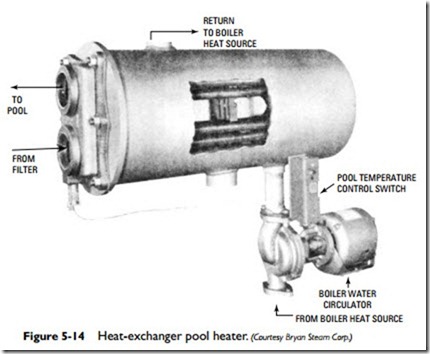Heat-Exchanger Pool Heaters
The heat-exchanger pool heater illustrated in Figure 5-14 is designed for use in either steam or hot-water heating systems. It is essentially a steel shell enclosing the copper tubes of the heat exchanger. The hot water or steam is taken from the heating main and circulated around the copper tubes inside the steel shell. The pool water enters the heat exchanger in a pipe leading from the pool filter and circulates inside the copper tubes. As it circulates, it is heated by the hot water or steam circulating around the copper tubes. The heated water eventually leaves the heat exchanger through a second exit point and is returned to the pool.
Figures 5-15 and 5-16 illustrate the modifications necessary for use with either steam or hot water as the heat source. Basic con- struction is essentially the same in both cases, with the pool water circulating through copper tubes (the heat exchanger) enclosed in a steel shell. You will probably notice that different types of steel are used in constructing the shell: 125-psi ASME steel for heat exchangers using hot water as a heat source, and 15-psi ASME steel for those using steam.
Both types of heat exchangers have temperature-control aquastats activated by the temperature of the pool water entering the heat exchanger. In heat exchangers that use water as a heat source, the aquastat is connected to a circulating pump (see Figure 5-16). If steam is the heat source, the aquastat is connected to a steam-control valve. Both the circulating pump and the steam-control valve control the rate of flow of the hot water or steam from the heating unit.
When steam is used as the heat source, the heat exchanger should also be equipped with a steam trap and a line running to the condensation main. The steam valve sizing is based on 2-psi minimum steam pressure and 0-psi return pressure. A steam strainer should be placed in the steam supply line just before it reaches the control valve.
Circulating pump sizing in units that use water as a heat source should be based on a maximum temperature drop through the heat exchanger of 30°F and a maximum head loss in piping between the hot-water boiler and the heater of 10 feet H2O.
The Btu/h output for heat-exchanger pool heaters using water as a heat source ranges from 200,000 to 4,200,000 Btu per hour. The amount will depend on water temperature (180°F or 210°F) and the size of the unit. Heaters using steam as a heat source are capable of generating an output of 400,000 to 3,600,000 Btu per hour. Here the difference depends on the steam pressure used (2 lbs or 10 lbs) and the size of the unit.
